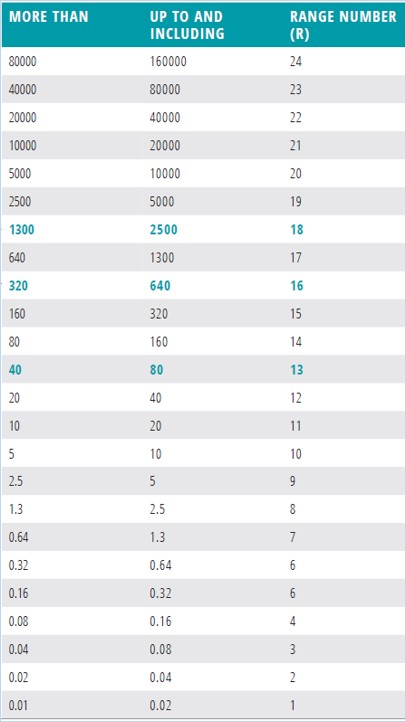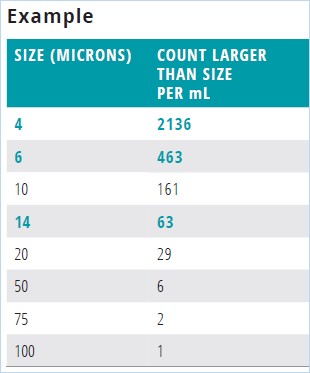-
myLab
-
Services
-
- Acid Number
- Analytical Ferrography
- Base Number: ASTM D2896 vs. D4739
- Crackle Test: Monitoring Water in Used Oil
- Demulsibility
- FTIR Direct Trend Methodology
- Fuel Distillation (ASTM D86)
- ISO Particle Count
- Karl Fischer Water Titration
- Optical Particle Classification (OPC)
- Remaining Useful Life Evaluation Routine (RULER)
- SEM-EDS Wear Debris Analysis
- Total Magnetic Iron (TMI)
- Varnish Potential
-
-
Sampling
-
- Coolant Sampling Procedures
- Grease Sampling Procedures
- Oil Sampling Basics (Short Course)
- Oil Sampling Procedures (Video)
- Oil Sampling Procedures: Good-Better-Best (PDF)
- Sample Collection Basics
- Sampling Oil Using a Drain Plug
- Sampling Oil Using a Pushbutton or KST-Series Valve
- Sampling Oil Using a Sample Pump
- Sampling Oil Using Thread-On Probe Style Valves
- Used Oil Filter Sampling
- Sampling from Filter Carts
-
-
Data Interpretation
-
- Analytical Ferrography Reporting
- Basic Testing Interpretation (PDF)
- Common Wear Mechanisms (PDF)
- DEF Specifications: ISO 22241
- Oil Cleanliness: ISO vs. NAS
- Potential Source of Spectrometry Metals (PDF)
- Reading the OA Report (PDF)
- Understanding ISO Particle Counts (PDF)
- Wear Metal Origins (PDF)
- Comparison: Wear Debris Analysis Technologies
- DEF Testing: Data interpretation
- Why Diesel Fuel Dilution is Bad for Your Engine
-
- Data Interpretation Process (Video)
- Data Interpretation: Compressors (Video)
- Data Interpretation: Diesel Engines (Video)
- Data Interpretation: Grease Analysis for Wind Turbines (VIDEO)
- Data Interpretation: Hydraulics (Video)
- Data Interpretation: Natural Gas Engines (Video)
- Data Interpretation: Oil Analysis for Wind Turbines (Video)
- Data Interpretation: Reducers (Video)
- Data Interpretation: Turbines (Video)
-
-
Whitepapers
-
Success Stories
-
FAQ
-
Release Notes
Understanding ISO Particle Counts (PDF)
ISO Particle Count is used to test for solids contamination (dirt, dust, wear) by counting the particles greater than 4, 6, and 14 microns. ISO Particle Count does not identify the actual contaminant elements.
Fluid Cleanliness Rating
A sample is given a fluid cleanliness rating using the table to the right. The ISO 4406:99 code system is based on the number of particles equal to or larger than three size ranges (4, 6, 14 microns or R4/R6/ R14) found in the equivalent of one millilitre of sample. The coding system is easer to use than reporting individual quantities of particles of each size range. It also allows manufacturers and maintenance staff to use similar terminology when discussing contamination.
Example
In the example shown, the particle count distribution at 4, 6, and 14 microns translates to a ISO rating of 18/16/13 using the corresponding Range Number (R) from the chart above.
Note that the code will never indicate a count of particles at the 6 or 14 micron size that is greater than the 4 micron size. All particles of 4 microns and greater also include the 6 and 14 micron particles.

Recommended Target ISO Cleanliness Codes
The downloadable chart provides recommended* target ISO cleanliness codes for systems using petroleum based fluids per ISO 4406 for particle sizes 4μ[C]/6μ[C]/14μ[C].
*NOTE:
- These are generic guidelines only. Please confirm exact oil cleanliness standards with OEM or filter supplier.
- Oil analysis flagging limits can be adjusted as needed. Please contact Fluid Life Customer Care for assistance at 1-877-962-2400 or [email protected].
Additional Resources
Article: What is…ISO Particle Count


